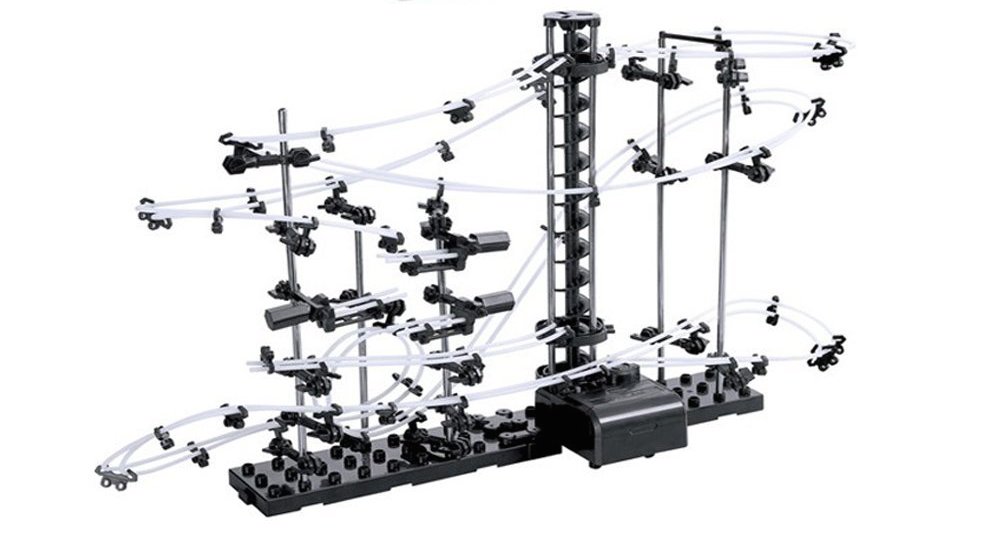Having spent last week at the ISTE2014 conference, I left a more inspired and motivated educator, not the least of which was because of presentations like the one by Phil Hansen who presented as part of the ISTE EdTekTalks.
As I sat and listened to him speak (see his TEDTalk below which is basically what he presented) I could not stop thinking about my 6th grade science project. My topic was “roller coaster physics” and I was comparing elliptical and spherical looped roller coasters and the differences in coaster velocity. While I have no recollection of my hypothesis or the results, I certainly remember being in tears one late evening working on my project. The marble would not go up the moving stairs! It was all over!
To test my theories of velocity, whatever they were, I was using one of those marble roller coasters (see blog image) made out of plastic tubes with an electric staircase that would push the marble step by step from the bottom of the coaster to the top. At the top gravity would take over and the marble would soar down the tube track I had designed. However, for some reason mine was defective and the marble would get stuck on the last step. I was not one to give up quickly, so I started problem solving.
First, I unscrewed the steps to see if there were any issues inside them. Nope. Next, looking closer at the last step, I thought there might have been a little extra plastic getting in the way so I found a nail file and filed away. Well that just made it worse. So, I did the next logical thing and grabbed a match and began to melt the step down. Suffice it to say, that was far from the solution and I had hit my wall. I ran to the couch, began to cry and, while my mother tried to console me, I would not be calmed. My entire science project was over, so I thought.
If you watch Phil’s TEDTalk below you will see that he hit a wall as well. Having focused on his passion for pointillism for years he injured his hand and was unable to create art the way he wanted. This type of art required fine motor skills his hands could no longer deliver. First he also tried to problem solve focusing only on the one way he thought he could create art; pointillism. He held the pen tighter and tighter until he could not longer create the fine points he needed. So, what did he do? He gave up. That was until his neurologist said why don’t you just create art a different way?
The simple fact was that Phil did not lose his creative ability. He had only lost the physical ability to tightly grasp a pen, which only limited his ability to create art one specific way. When he finally accepted that the limitation was only his hands and not his creativity, he was able to realize the limitless creative ability he always and still had. He just had to get unstuck from his focus on why he could not create one specific way and start thinking about how he can create a thousand other ways. Once he realized how he was limited he become limitless.
My 6th grade roller coaster disaster certainly was not the same as Phils struggle, but I did get stuck thinking that the only way for the coaster to work was to use the stairs. However, after some consolation from my mother, she asked me why don’t you just drop the marble from the top yourself and not use the stairs? Um…….yea! Why not? I had been so focused on what was not working and not accepting the limit that I placed on the project, that I was not exploring alternative methods to accomplish the same goal.
It is easy to get hyper focused on what does not work when something does not go the way you had hoped. However, as Phil said at the EdTekTalk, “embracing a limitation can actually drive creativity.”
So, can we apply Phil’s embracing of the shake to our classrooms?
As educators we want our students to have as many options to success as possible. However, for this to be true it first requires more pathways to success integrated into the curriculum and the models of teaching and learning we use. We can’t have only one way to learn or illustrate learning. This is not how it is in the real world and is not the way it should be in our classrooms. Yet in our current system of standardized testing, drill and kill lessons and industrial bell schedules herding our students from class to class embracing a limitation means failure without opportunity for relearning. This is not real world learning. A rigid classroom does not drive creativity, it destroys it.
So, while I loved Phil’s message and see how valuable it is to the classroom, it requires a transformation of teaching and learning. This is certainly possible and is slowly happening in classrooms and schools around the country. However, maybe it could happen faster if our teachers “embrace the shake” and realize the limitations of our current system so that they, like Phil, become limitless.
Oh, if you were wondering, I did very well at the science fair and went to the county science fair taking home the third place ribbon in physics.
Cross-posted on EJsCafe.com











Leave a reply
You must be logged in to post a comment.